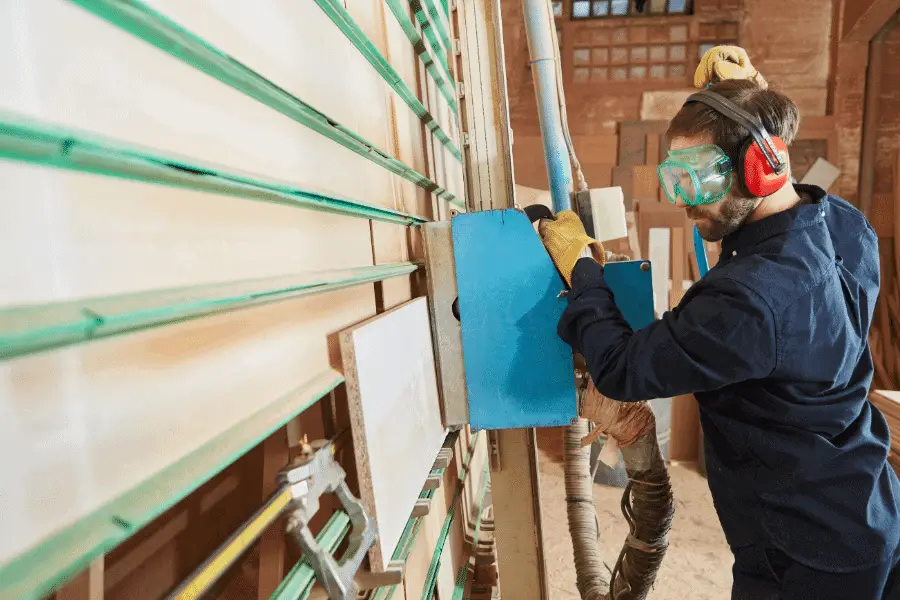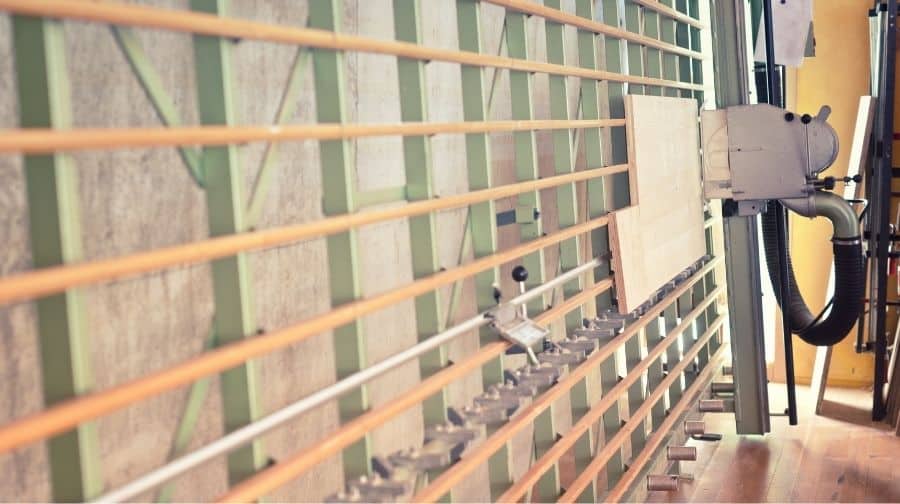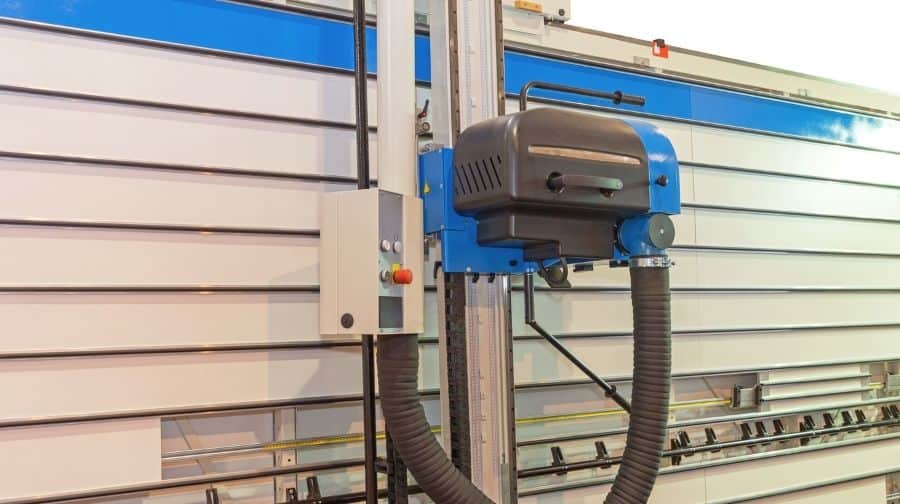
A Panel Saw is a large shop tool used to cut sheet goods into smaller pieces.
There are so many helpful options when it comes to saws for your project. Each tool has a specific purpose and function that separates it from the others. I’ve researched through the internet and put together a quick summary on the panel saw.
What is a panel saw used for? A panel saw is used for making long, accurate cuts in large pieces of sheet material, such as plywood, particle board, and melamine. It is an important tool for cabinetmakers, woodworkers, and other professionals who work with sheet goods.
Keep reading below to learn more about the panel saw and what it can be used for.
What Is A Panel Saw Used For?
A panel saw is used for making long, accurate cuts in large pieces of sheet material, such as plywood, particle board, and melamine. It is an important tool for cabinetmakers, woodworkers, and other professionals who work with sheet goods.
A panel saw typically consists of a base with a sliding table on top. The table has a fence that runs along one edge, and the saw blade is mounted on a rail that runs along the other edge. The table can be moved back and forth, and the fence can be adjusted to make different size cuts.
Dealing with sheet goods can be a headache. They’re sometimes too large to make specific cuts on a table saw, and using a circular saw is always a gamble as to whether you can make the cuts you need and keep them straight.
You could solve the problem of curvy cuts with a track saw, or, you could use a Panel Saw. They are commonly used to make vertical crosscuts and horizontal rip cuts on large sheet materials. You can also attach a router to your panel saw.
What Is A Panel Saw?
A Panel Saw is defined as any saw that is designed to cut large sheet goods into smaller pieces. For the purposes of this article, we’ll be discussing a Panel Saw like the ones you may have seen at any of the major hardware chains that sell lumber.
One of the best things about a Panel Saw is how safe it is. There is no exposure to the blade as with a table saw, so your fingers are not in danger. A Panel Saw typically consists of a large metal frame that rests on an incline, so you can safely stand your sheet goods in the frame. At the base of the frame, you will see a rail guarding a row of rollers along the length of the rack to allow your material to slide back and forth with ease.
The saw itself is fully enclosed inside a metal housing. The blade’s housing is attached to guide rails, found in the center of the frame, that allow the blade to move up or down in a perfectly straight line. You will find a large power button on the saw that makes power-on and shutdown extremely easy. The saw is held stationary with a carriage-lock on one of the rails that can be both loosened and tightened by screwing or unscrewing a large handled bolt.
Not only can the Panel Saw make beautifully straight cuts on the vertical axis, but it can also be turned on the axis and locked in place to make horizontal cuts. To turn it, first power-down the machine, slide the saw into position vertical and ensure that it is tightly secured, then pull the spring-loaded release pins and turn the saw clockwise, lining the pins up with corresponding holes and letting them click into place. Now that the blade is positioned for the rip cut, you can make long cuts along the entire length of the sheet.

How Does A Panel Saw Work?
A panel saw works by holding a large panel of wood or other material in place while the operator moves a blade along it, making precision cuts. This type of saw is often used in woodworking or cabinetmaking, as it can make very clean, straight cuts with little effort.
If you’re looking to add a panel saw to your shop, there are a few things you should keep in mind. First, panel saws come in two basic types: rip and crosscut. Rip panel saws are designed to cut along the grain of the wood, while crosscut panel saws are meant to cut across the grain. You’ll need to decide which type is best for your needs before making a purchase.
Before you begin work, always remember to make certain that your area is clean of debris. We also recommend that you wear proper protective equipment such as protective eyeglasses, ear coverings, and possibly work gloves. Once you have made sure that it is safe to proceed, then it’s time to make some cuts.
When loading your materials onto the frame, you will stand it on its side and slide it onto the rollers and lean it against the back frame. Slide the material behind the saw. To ensure that you have positioned your material correctly, line your material up using the measuring guide built into one the horizontal rails of the frame. The guide rails for the saw also have a measuring guide so that you can be certain of the height of the blade for your rip cuts.
Once you have ensured that your materials are correctly positioned, power-on the saw and simply drag it straight down, across the surface of the material for a crosscut. If your material is hanging off the edge of the frame, you will want to keep a firm hand on it or clamp it to the frame so that when you finish your cut, it does not fall to the floor.
To make a rip cut, position your blade to the correct height, and lock it into place. For this, you will not have to move the saw at all. You will slide your material across the frame on the rollers, pushing it across the blade, similar to operating a table saw.
There is no easier or safer way to cut large sheet materials into more manageable sizes. However, these machines are very large, thus taking up a great deal of space in the shop. If you do not have room for a Panel Saw in your home shop, and you still need to make straight cuts to large sheet goods, take a look on this website at the article on Track Saws.
Versatility of a Panel Saw
Subscribe to WoodWorkers Guild Of America on Youtube
Pro Tip: For smooth, clean, chip-free cuts, you must use industrial carbide saw blades that are sharp. Dull or improperly sharpened blades will cause chipping, unclean cuts, chatter, and motor overloading.
What Is The Difference Between A Table Saw And A Panel Saw?
The table saw and panel saw are similar and used for similar cuts but the main difference is the panel saw is used to cut large sheet materials that are too large to fit on a table saw.
The panel saw can conveniently be placed along the wall in your shop keeping it out of the way and the table saw will require more interior space in your shop. Table saws can be more versatile and are more commonly used. If your not going to be cutting large sheets of wood often then it’s best to have a table saw in your shop over a panel saw.
What Is The Best Panel Saw?
What Can You Not Cut With A Panel Saw?
You can not cut metal, round stock or anything that won’t fit on the panel saw rollers. Also any workpieces that are too think to fit through your panel saw. You can make cuts that require curves and shaping can’t be made by the panel saw.
Does Home Depot Have A Panel Saw?
Yes, Home Depot has a panel saw and they will cut your workpieces to size for free for you.

Does Lowes Have A Panel Saw?
Yes, Lowes has a panel saw and they will cut your workpieces to size for free for you.
How Long Is A Panel Saw?
A panel saw can be as short as 3 feet long and as long as 10-12 feet.
Subscribe to Beauty and the Bolt on Youtube
How To Clean Your Panel Saw.
Use only mild soap and a damp cloth to clean the tool, because certain cleaning agents and solvents are harmful to plastics and other insulated parts. Some of these include: gasoline, turpentine, lacquer thinner, paint thinner, chlorinated cleaning solvents, ammonia, and household detergents containing ammonia. Never use flammable or combustible solvents around tools.
